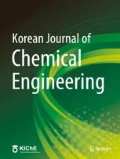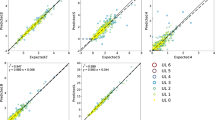Abstract
The effect of molecular interaction energy among different molecules in the mixed solutions significantly depends upon the size of individual molecule size and molecular arrangement. In order to compensate these effects on the existing method, a new method of representing the relationship of temperature and compositions of each phase (vapor and liquid phases in equilibrium) and azeotropic mixture is proposed. The optimized models of the RSM (response surface methodology) and MRSM (modified response surface methodology) are briefly described. The applications of these models to the solution thermodynamics are also explained.
Similar content being viewed by others
References
Abram, D.S. and Prausnitz, J. M.,“Statistical Thermodynamics of Liquid Mixtures: A New Expression for the Excess Gibbs Energy of Partly of Completely Miscible System”,AIChE J,21, 116(1975).
Box, G. E. P.,“The Extrapolation and Exploitation of Response Surface: Some General Consideration and Examples”,Biometrics,10, 16(1954).
Chao, K. C. and Hougen, O. A.,“Vapour-Liguid Equilibria in the Ternary System Ethyl Acetate-Benzene-Cyclohexane”,Chem. Eng. Sci.,7, 246(1958).
Fredenslund, A., Gmehling, J. and Rasmussen, P.,“Vapor-Liquid Equilibrium Using UNIFAC”, Elsevier, Amsterdam, 1979.
Gmehling, J., Onken, U. and Arlt, W.,“Vapor-Liquid Equilibrium Data Collection”, Chemistry Data Series, DECHEMA, Germany, 1981.
Ha, D. M. and Park, J. C.,“The Representation of Ternary System by the Estimation of Group-Group and Interaction Parameters for MRSM-1 Model”,HWAHAK KONGHAK,29(3), 284(1991).
Hill, W. J. and Hunter, W. G.,“A Review of Response Surface Methodology: A Literature Survey”,Technometric,8, 571 (1966).
Hilm, A. K., Ellis, S. R. M. and Barker, P. E.,“Method of Evaluating Activity Coefficient Parameters”,British Chemical Engineering,15, 1321(1970).
Hu, Y., Liu, H. and Prausnitz, J. M.,“A Model-Free Method for Calculating Vapor-Liquid Equilibria for Multicomponent Systems from Total-Pressure of Boiling-Point Data”.Fluid Phase Equilibria,93, 73(1994).
Kim, M. G., Ha, D. M. and Park, J. C.,“Modified Response Surface Methodology (MRSM) for Phase Equilibrium-Application”,KJChE,12(1), 39(1995).
King, M. B.,“Phase Equilibrium in Mixtures”, Pergamon Press, London, 1969.
Kojima, K. and Tochigi, K.,“Prediction of Vapor-Liquid Equilibria by the ASOG Method”, Elsevier, Amsterdam, 1979.
Lee, L. L. and Starling, K. E.,“The Statistical Mechanical Local Composition Theory: The Balance Equations and Concentration Effects in Nonideal Mixtures”,Fluid Phase Equilibria,21, 77 (1985).
Lee, L. L,“Molecular Thermodynamics of Nonideal Fluids”, Butterworths, Boston, 1988.
Lu, B. C. Y., Li, J. C. M. and Ting, T. W.,“Cluster Theory of Vapor-Liquid Equilibria”,Ind. Eng. Chem.,51, 219(1959).
Malesinski, W.,“Azeotropy and Other Theoretical Problems of Vapor-Liquid Equilibrium”, Polish Scientific Publishers, Warszawa, 1965.
Nagata, I.,“Vapor-Liquid Equilibria for the Ternary System Methyl Acetate-Benzene-Cyclohexane”,J. Chem, Eng. Data,7, 461 (1962).
Park, J. C.,“Prediction of the Activity Coefficients for Non-Ideal Liquid Mixtures”, The 183rd Meeting of European Federation of Chem. Engineers at Helsinki, Finland, June (1977).
Park, J. C.,“Estimation of the Activity Coefficients for Non-Ideal Liquid Mixtures”, Theses Collection. Kyung Hee Univ.,9, 555 (1979).
Park, J. C.,“Estimation of the Activity Coefficients for Non-Ideal Liquid Mixtures: Effect of Variables of TPTT Equations on Response Model of Molecular Interaction Energy Parameters of Two and Three Component Systems”, Theses Collection. Kyung Hee Univ.,11, 139(1982).
Park, J. C.,“Estimation of Activity Coefficients for Non-Ideal Liquid Mixtures: Selection of Response Surface Model by Means of Response Surface Methodology for Multicomponent System”, PACHEC Proceeding,2, 340 (1983).
Park, J. C.,“Estimation of Multicomponent Phase Surface by Means of Response Surface Methodology and Comparison of Fitting for 3 & 4 Component Systems”, Kyung Hee Univ. Publication, Seoul, Korea, 1985.
Park, J. C.,“The Partial Molar Interaction Energy of the TPTT Equation”, Theses Collection, Kyung Hee Univ.,15, 239(1986).
Park, J. C.,“Representation of Multiple Phase Response Surface by Means of Computer Graphics”, Kyung Hee Univ. Publication, Seoul, Korea, 1987.
Park, J. C. and Kim, M. G.,“Comparative Analysis of the TPTT. MPMT and RSM Models”,HWAHAK KONGHAK,26(2), 194 (1988).
Park, J. C,“Mandang, Park, Jong-Chul, Ph.D., Full Professor, 60th Birthday Anniversary Theses Collection”, Munyangsa, Seoul, Korea, 1988.
Park, J. C., Ha, D M. and Kim, M. G.,“Estimation Methodology of Multicomponent Phase Equilibria by Group-Group and Interaction Parameters”, Proc. 5th APCChE Congress, 4a-14, Kuala Lumpur, Malaysia (1990).
Park, J. C,“Theory and Practice of Modified Response Surface Methodology in Phase Equilibrium”, KIChE meeting, April (1991a).
Park, J. C,“Theory and Practice of Modified Response Surface Methodology in Phase Equilibrium”, 68th Annual Meeting of the Korean Chemical Society, Changwon, Korea (1991b).
Park, J. C,“Mandang, Park, Jong Chul, Ph.D. Honorable Retirement Commemoration Theses Collection”, Munyangsa, Seoul, Korea, 1992.
Prausnitz, J. M., Lichtenthaler, R. N. and de Azevedo, E. G.,“Molecular Thermodynamics of Fluid Phase Equilibria”, 2nd ed., Prentice-Hall Inc. Englewood Cliffs, N.J., 1986.
Redlich, O. and Kister, A. T.,“On the Thermodynamics of Non-Electrolyte Solution and Its Technical Application: III. Systems with Associated Components”,J. Chem. Phys.,15, 849(1947).
Reid, R. C., Prausnitz, J. M. and Poling, P. E.,“The Properties of Gases and Liquids”, 3rd ed., McGraw-Hill, New York, 1986.
Renon, H. and Prausnitz, J. M.,“Local Compositions in Thermodynamic Excess Functions for Liquid Mixtures”,AIChE J.,14, 135 (1968).
Shin, H. S. and Park, J. C.,“Comparison of Methods of Estimating VLE by Means of the Wilson, NRTL, UNIQUAC Equations for Ternary Systems by Computer Graphics”, Theses Collection, Kyung Hee Univ.,17, 497 (1988).
Wilson, G. M.,“Vapor-Liquid Equilibrium. XI. A New Expression for the Excess Energy of Mixing”,J. Am. Chem. Soc,86, 127 (1964).
Wisniak, J. and Tamir, A.,“Vapor-Liquid Equilibria in the Ternary Systems Water-Formic Acid-Acetic Acid and Water-Acetic Acid-Propionic Acid”,J. Chem. Eng. Data,22, 253(1977).
Author information
Authors and Affiliations
Rights and permissions
About this article
Cite this article
Park, JC., Ha, DM. & Kim, MG. Modified response surface methodology (MRSM) for phase equilibrium-theoretical background. Korean J. Chem. Eng. 13, 115–122 (1996). https://doi.org/10.1007/BF02705897
Received:
Accepted:
Issue Date:
DOI: https://doi.org/10.1007/BF02705897




